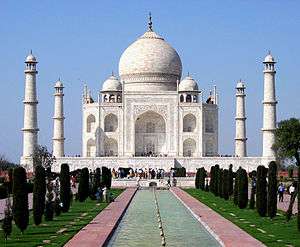Agra
Agra (/ˈɑːɡrə/ (![]()
Agra | |
|---|---|
 .jpg)   From top: The Taj Mahal, Shivaji monument in front of Agra Fort, Tomb of Akbar the Great, Tomb of I'timād-ud-Daulah. | |
| Nickname(s): The Taj City (Taj Nagari) | |
 Agra  Agra 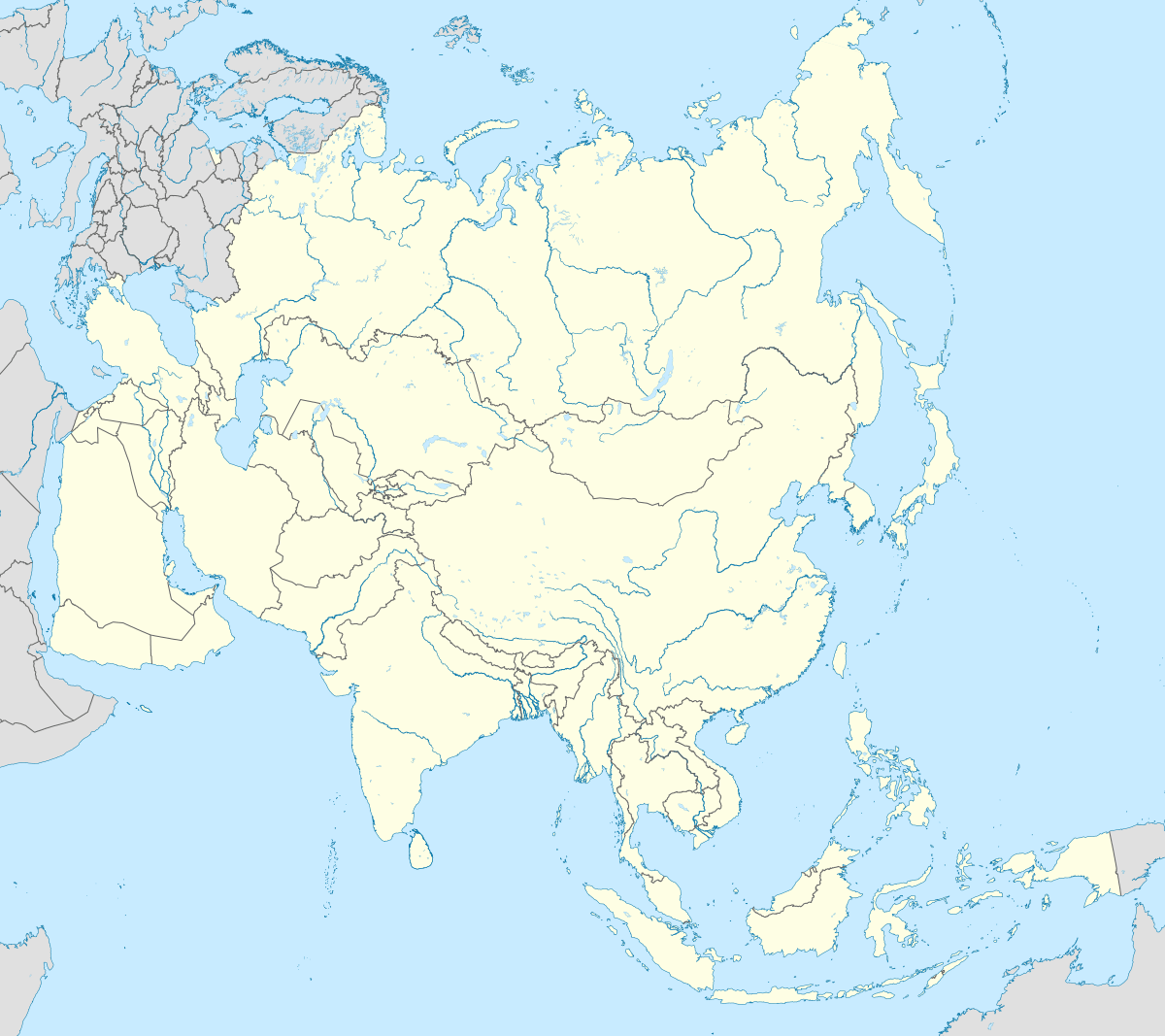 Agra | |
| Coordinates: 27.18°N 78.02°E | |
| Country | |
| State | Uttar Pradesh |
| Division | Agra |
| District | Agra |
| Government | |
| • Type | Municipal Corporation |
| • Body | Agra Municipal Corporation |
| • Mayor[1] | Naveen Jain (BJP) |
| • Divisional Commissioner | Anil Kumar, IAS[2] |
| • Inspector General | A. Satish Ganesh, IPS[3] |
| • District Magistrate and Collector | Prabhu Narain Singh IAS[4] |
| • Senior Superintendent of Police | Babloo Kumar, IPS[5] |
| Elevation | 171 m (561 ft) |
| Population (2011)[6] | |
| • City | 1,585,704 |
| • Rank | 24th |
| • Metro | 1,760,285 |
| Language | |
| • Official | Hindi[8] |
| • Additional official | Urdu[8] |
| • Local | Braj Bhasha |
| Time zone | UTC+5:30 (IST) |
| Telephone code | 0562 |
| Vehicle registration | UP-80 |
| Sex ratio | 875 ♀ / 1000 ♂ |
| Literacy | 73.11% |
| Website | Official District Website |
The 11th-century Persian poet Mas'ūd Sa'd Salmān writes of an assault on the fortress of Agra, then held by King Jaypal, by Mahmud of Ghazni. Despite his surrender, Mahmud sacked the place.[11] A 17th century chronicle called Agra before Sikandar Lodī's time (1488–1517) as an old settlement which was merely a village, owing to its destruction by Mahmud of Ghazni.[12] Sikandar was the first sultan to move his capital from Delhi to Agra in 1504, its administration having previously been under Bayana.[13][14] He governed the country from here and Agra assumed the importance of the second capital. He died in 1517 and his son, Ibrāhīm Lodī, remained in power there for nine more years. Several palaces, wells, and a mosque were built by him in the fort during his period. He was defeated at the Battle of Panipat in 1526.[15] Between 1540 and 1556, Afghans, beginning with Sher Shah Suri, ruled the area. It was the capital of the Mughal Empire from 1556 to 1648. The city was later taken by the Marathas and later still fell to the British Raj.
Agra is a major tourist destination because of its many Mughal-era buildings, most notably the Taj Mahal, Agra Fort and Fatehpur Sikri, all of which are UNESCO World Heritage Sites.[9] Agra is included on the Golden Triangle tourist circuit, along with Delhi and Jaipur; and the Uttar Pradesh Heritage Arc, a tourist circuit of Uttar Pradesh, along with Lucknow and Varanasi. Agra is in the Braj cultural region.
Climate
Agra features a semiarid climate that borders on a humid subtropical climate. The city features mild winters, hot and dry summers and a monsoon season. However, the monsoons, though substantial in Agra, are not quite as heavy as the monsoon in other parts of India. This is a primary factor in Agra featuring a semiarid climate as opposed to a humid subtropical climate.
| Climate data for Agra, India (1981–2010, extremes 1901–2002) | |||||||||||||
|---|---|---|---|---|---|---|---|---|---|---|---|---|---|
| Month | Jan | Feb | Mar | Apr | May | Jun | Jul | Aug | Sep | Oct | Nov | Dec | Year |
| Record high °C (°F) | 33.0 (91.4) |
35.6 (96.1) |
42.8 (109.0) |
46.5 (115.7) |
48.6 (119.5) |
48.5 (119.3) |
46.5 (115.7) |
43.0 (109.4) |
41.4 (106.5) |
41.1 (106.0) |
36.1 (97.0) |
31.0 (87.8) |
48.6 (119.5) |
| Average high °C (°F) | 22.7 (72.9) |
26.0 (78.8) |
32.1 (89.8) |
38.1 (100.6) |
41.9 (107.4) |
41.5 (106.7) |
36.0 (96.8) |
33.7 (92.7) |
34.5 (94.1) |
34.5 (94.1) |
29.7 (85.5) |
24.5 (76.1) |
32.9 (91.2) |
| Average low °C (°F) | 7.5 (45.5) |
9.9 (49.8) |
14.4 (57.9) |
20.0 (68.0) |
24.6 (76.3) |
26.3 (79.3) |
25.0 (77.0) |
23.8 (74.8) |
22.8 (73.0) |
18.0 (64.4) |
12.4 (54.3) |
7.8 (46.0) |
17.7 (63.9) |
| Record low °C (°F) | −2.2 (28.0) |
−1.7 (28.9) |
5.6 (42.1) |
10.0 (50.0) |
14.0 (57.2) |
12.0 (53.6) |
14.5 (58.1) |
12.0 (53.6) |
13.0 (55.4) |
9.4 (48.9) |
2.8 (37.0) |
−0.6 (30.9) |
−2.2 (28.0) |
| Average rainfall mm (inches) | 12.4 (0.49) |
12.1 (0.48) |
8.8 (0.35) |
12.3 (0.48) |
22.6 (0.89) |
81.7 (3.22) |
214.9 (8.46) |
230.2 (9.06) |
129.6 (5.10) |
29.4 (1.16) |
3.4 (0.13) |
3.5 (0.14) |
760.7 (29.95) |
| Average rainy days | 1.3 | 1.0 | 1.2 | 0.9 | 2.0 | 3.2 | 10.4 | 10.7 | 8.0 | 1.4 | 0.4 | 0.4 | 39.0 |
| Average relative humidity (%) (at 17:30 IST) | 58 | 47 | 39 | 35 | 35 | 40 | 66 | 73 | 63 | 49 | 52 | 58 | 51 |
| Source: India Meteorological Department[16][17] | |||||||||||||
Population
Demographics
As of 2011 India census,[6][18] Agra city has a population of 1,585,704, while the population of Agra cantonment is 53,053. The urban agglomeration of Agra has a population of 1,760,285.[18] Males constitute 53% of the population and females 47%. Agra city has an average literacy rate of 73%, below the national average of 74%.[18] Literacy rate of males is considerably higher than that of women. The sex ratio in the city was 875 females per thousand males while child sex ratio stood at 857.[18] Agra district literacy rate is 62.56%.[19]
According to the 2011 census, Agra district has a population of 4,380,793,[20] roughly equal to the nation of Moldova[21] or the US state of Kentucky.[22] This gives it a ranking of 41st in India (out of a total of 640).[20] The district has a population density of 1,084 inhabitants per square kilometre (2,810/sq mi) .[20] 52.5% of Agra's population is in the 15–59 years age category. Around 11% of the population is under 6 years of age.
Religion
Hindus are 88.8% while Muslims are 9.3% of the population in Agra district.[23] Hinduism, Islam and Jainism are the major religions in Agra city with 80.7%, 15.4% and 1.0% of the population adhering to them; others are 2.9%. The Catholic minority is served by its own Metropolitan Archdiocese of Agra.
History
Medieval era
Masud Sa'd Salman claims to have been there when Mahmud assaulted Agra, claiming the Raja Japal surrendered after seeing a nightmare. Mahmud however proceeds to pillage the city.[11] The history of the city before the Muslim conquerors is unclear. The 17th century chronicler named Abdhullah said it was a village before the reign of Sikandar Lodi. The king of Mathura had used the Agra fort as a jail. The degradation in the status of the site was a result of the destruction brought upon it by Mahmud of Ghazni.[12] Sultan Sikandar Lodī, the Muslim ruler of the Delhi Sultanate, shifted his capital to Agra in the year 1504. Before this, it was under the lordship of Bayana.[14] After the Sultan's death, the city passed on to his son, Sultan Ibrāhīm Lodī. He ruled his Sultanate from Agra until he fell fighting to Mughal Badshah Bābar in the First battle of Panipat fought in 1526.
Mughal era
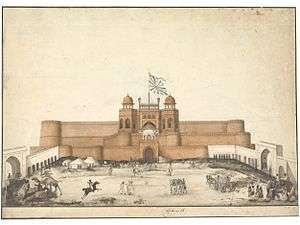
The golden age of the city began with the Mughals. Previously known as Akbarabād, Agra was the capital of the Mughal Empire under the Badshahs Akbar, Jahāngīr and Shāh Jahān. Akbar made it the eponymous seat of one of his original twelve subahs (imperial top-level provinces), bordering (Old) Delhi, Awadh (Oudh), Allahabad, Malwa and Ajmer subahs. Shāh Jahān later shifted his capital to Shāhjahānabād in the year 1648.[24]
Since Akbarabād was one of the most important cities in India under the Mughals, it witnessed a lot of building activity. Babar, the founder of the Mughal dynasty, laid out the first formal Persian garden on the banks of the river Yamuna. The garden is called the Arām Bāgh or the Garden of Relaxation. His grandson Akbar the Great raised the towering ramparts of the Great Red Fort, besides making Agra a centre for learning, arts, commerce, and religion. Akbar also built a new city on the outskirts of Akbarabād called Fatehpur Sikri. This city was built in the form of a Mughal military camp in stone.

His son Jahāngīr had a love of flora and fauna and laid many gardens inside the Red Fort or Lāl Qil'a. Shāh Jahān, known for his keen interest in architecture, gave Akbarabād its most prized monument, the Taj Mahal. Built in loving memory of his wife Mumtaz Mahal, the mausoleum was completed in 1653.
Shāh Jahān later shifted the capital to Delhi during his reign, but his son Aurangzeb moved the capital back to Akbarabād, usurping his father and imprisoning him in the Fort there.
Later periods
The Jat kingdom of Bharatpur waged many wars against the Mughal Delhi and in the 17th and 18th century carried out numerous campaigns in Mughal territories including Agra.[25]
After the decline of the Mughal Empire, the city came under the influence of Marathas and was called Agra, before falling into the hands of the British Raj in 1803.
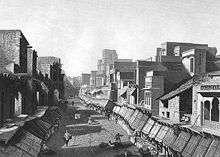
.jpg)
In 1835 when the Presidency of Agra was established by the British, the city became the seat of government, and just two years later it was witness to the Agra famine of 1837–38. During the Indian rebellion of 1857 , British rule across India was threatened, news of the rebellion had reached Agra on 11 May and on 30 May two companies of native infantry, the 44th and 67th regiments, rebelled and marched to Delhi. The next morning native Indian troops in Agra were forced to disarm, on 15 June Gwalior (which lies south of Agra) rebelled. By 3 July, the British were forced to withdraw into the fort. Two days later a small British force at Sucheta were defeated and forced to withdraw, this led to a mob sacking the city. However, the rebels moved onto Delhi which allowed the British to restore order by 8 July. Delhi fell to the British in September, the following month rebels who had fled Delhi along with rebels from Central India marched on Agra but were defeated. After this British rule was again secured over the city until the independence of India in 1947.[26]
Legacies
Agra is the birthplace of the religion known as Dīn-i Ilāhī, which flourished during the reign of Akbar and also of the Radhaswami Faith, which has around two million followers worldwide. Agra has historic linkages with Shauripur of Jainism and Runukta of Hinduism, of 1000 BC. The Taj Mahal, Agra Fort and Fatehpur Sikri are all UNESCO World Heritage Sites.
Administration and politics
Administration
General administration
Agra division which consists of four districts, and is headed by the divisional commissioner of Agra, who is an IAS officer, the commissioner is the head of local government institutions (including municipal corporations) in the division, is in charge of infrastructure development in his division, and is also responsible for maintaining law and order in the division.[27][28][29][30] The district magistrate of Agra reports to the divisional commissioner. The current commissioner is K. Ram Mohan Rao.[31][2][32]
Agra district administration is headed by the district magistrate and collector (DM) of Agra, who is an IAS officer. The DM is in charge of property records and revenue collection for the central government and oversees the elections held in the city. The DM is also responsible for maintaining law and order in the city.[27][33][34][35] The DM is assisted by a chief development officer; six additional district magistrates for finance/revenue, city, administration, land acquisition, civil supply, and protocol; one city magistrate; and three additional city magistrates.[32] The district has six tehsils viz. Sadar, Etmadapur, Kirawali, Fatehabad, Khairagarh and Bah, each headed by a Sub-Divisional Magistrate.[32] The current DM is Prabhu Narain Singh.[4]
Police administration
Agra district comes under the Agra Police Zone and Agra Police Range, Agra Zone is headed by an additional director general (ADG)-ranked Indian Police Service (IPS) officer, and the Agra Range is headed by a deputy inspector general (DIG)-ranked IPS officer. The current ADG, Agra Zone is Ajay Anand,[36] and IG, Agra Range is A. Satish Ganesh.[3]
The district police is headed by a senior superintendent of police (SSP), who is an IPS officer, and is assisted by six superintendents of police or additional superintendents of police for city, east, west, crime, traffic, and protocol, either from the IPS or the Provincial Police Service.[5] Each of the several police circles is headed by a circle officer in the rank of deputy superintendent of police.[5] The SSP is Babloo Kumar as of October 2019.[5]
Infrastructure and civic administration
The development of infrastructure in the city is overseen by Agra Development Authority (ADA), which comes under the Department of Housing and Urban Planning of the Uttar Pradesh government. The Divisional Commissioner of Agra acts as the ex-officio Chairman of ADA, whereas a vice-chairman, a government-appointed IAS officer, looks after the daily matters of the authority.[37] The current vice-chairman of ADA is Shubhra Saxena.[38]
The Agra Municipal Corporation oversees the city's civic infrastructure. The head of the corporation is the mayor, but the executive and administration of the corporation is the responsibility of the municipal commissioner, who is an Uttar Pradesh government-appointed Provincial Civil Service officer of high seniority. The current mayor of Agra is Naveen Jain from the Bharatiya Janata Party, whereas the municipal commissioner is Arun Prakash.[39][40]
Politics
Agra district has two Lok Sabha constituencies, Agra and Fatehpur Sikri, and nine Uttar Pradesh Vidhan Sabha (Uttar Pradesh Legislative Assembly) constituencies. The MP for Agra constituency is SP Singh Baghel and the MP for Fatehpur Sikri constituency is Rajkumar Chahar. Both are members of the Bharatiya Janata Party.
Local Administration
Agra Municipal Corporation is divided into 100 wards[41] for the purpose of local administration.
Transport
Air
Air India and its subsidiary, Alliance Air, fly to Agra airport. Zoom Air also commences flight operations to Jaisalmer and New Delhi from Agra Airport.[42] Indigo will start flights to Bangalore from 27 March 2020 and direct flights from Lucknow, Varanasi and Bhopal to Agra Airport from 29 March 2020.[43]
Rail
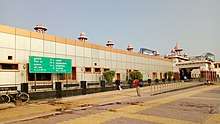
Agra City comes under the jurisdiction Of Agra Division Of North Central Railways Zone of the Indian Railways . Agra is on the Central Train line between Delhi (Station Code: NDLS) and Mumbai (Station Code: CSTM) and between Delhi and Chennai (Station Code: MAS) and many trains like Bhopal Shatabdi, Taj Express, Doon Express, Gatimaan Express, Bhopal Express, Malwa Express, Gondwana Express, Jabalpur - Jammutawi Express, Shreedham Express, Garib Rath, Tamil Nadu Express, Chennai Rajdhani, Agra Mathura Express etc. connect Agra with all major Indian cities like New Delhi, Hyderabad, Mumbai, Kolkata, Chennai, Visakhapatnam, Bengaluru, Pune, Bhopal, Indore, Kanpur, Kochi, Gwalior, Meerut, Saharanpur, Dehradun, Jabalpur, Ujjain, Jaipur, Haridwar, Aligarh, Mathura, Alwar, Lucknow, Thiruvananthapuram etc. every day. Some east-bound trains from Delhi also travel via Agra, so direct connections to points in Eastern India (including Kolkata) are also available. There are close to 20 trains to New Delhi and Gwalior Junction every day, and at least three or four to Bhopal, Indore, Nagpur, Mumbai and Chennai. There are three main railway stations in Agra: Agra Cantt, Raja Ki Mandi, and Agra Fort.
Railway Stations served by the Agra Division, North Central Railways network at Agra are:
- Agra Cantonment Railway Station, Agra
- Agra Fort Railway Station, Agra
- Agra City Railway Station, Agra
- Raja Ki Mandi Railway Station, Agra
- Idgah Railway Station, Agra
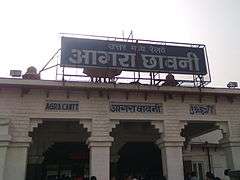
Agra-Delhi Semi-High Speed Train – Gatimaan Express
In July 2014, a trial run of a "semi-high speed train" with 10 coaches and 2 generators reached a speed of 160 km/h (99 mph) between New Delhi and Agra. This is of the same class as New Delhi Agra Shatabdi Express, which takes 2 hours to complete its journey. The new semi-high speed train Gatimaan Express that reduces travel time between Delhi and Agra began in April 2016.
Road
.jpg)
Inter-State Bus Terminal (I.S.B.T.), Idgah Bus Stand, Taj Depot and Fort Depot are the major bus stands in Agra, connecting Agra to most of the bigger cities in northern India. It is a major junction of highways with three national highways and two expressways (Yamuna Expressway & Agra Lucknow Expressway) originating from Agra.
- From Delhi: NH 19 (old number: NH 2), a modern divided highway, connects the 200 km (124 mi) distance from Delhi to Agra.
- From Delhi / Noida: Yamuna Expressway, a modern access controlled highway connects the 200 km (124 mi) distance from Delhi to Agra.
- Yamuna Expressway (formerly Taj Expressway) is a six lane, 165 km (103 mi) long, controlled-access expressway, that connects New Delhi with Agra via Greater Noida and Mathura in the Indian state of Uttar Pradesh.
- NH 509 (old number: NH 93) connects Agra to Moradabad via Aligarh.
- Agra Lucknow Expressway is a six lane, 302 km (188 mi) long, controlled-access expressway, that connects Lucknow with Agra via Kannauj and Etawah in the Indian state of Uttar Pradesh.
Bus services are run by the Agra Municipal Corporation. Other para-transit modes include rickshaws. Polluting vehicles are not allowed near the Taj Mahal.
Agra Metro
Rail India Technical and Economic Service (RITES) has proposed 30 stations, 11 underground and 19 elevated, for two corridors of the Metro Rail in the city. The two routes are Sikandra to the Taj Mahal's east gate via Agra Fort and Agra Cantt to Kalindi Vihar. On 24 March 2017, State Chief Minister Yogi Aditya Nath approved the project. In December 2017, the cabinet of the UP Government approved the DPR as per New Metro Policy. Prime Minister Narendra Modi laid the foundation stone of Agra Metro on 8 March 2019.[44]
Monumental Mughal legacy
Taj Mahal


The Taj Mahal is one of the most famous buildings in the world, the mausoleum of Shah Jahan's favourite wife, Mumtaz Mahal. It is one of the New Seven Wonders of the world, and one of the three World Heritage Sites in Agra. Agra is commonly identified as the "City of Taj".[45]
Completed in 1653, the Taj Mahal was built by the Mughal king Shah Jahan as the final resting place for his beloved wife, Mumtaz Mahal. Finished in marble, it is one of India's many beautiful monuments and is set amidst landscaped gardens. Built by the Persian architect, Ustād 'Īsā, the Taj Mahal is on the south bank of the Yamuna River. It can be observed from Agra Fort from where Emperor Shāh Jahān gazed at it for the last eight years of his life, a prisoner of his son Aurangzeb. Verses of the Quran are inscribed on it and at the top of the gate are 22 small domes, signifying the number of years the monument took to build. The Taj Mahal was built on a marble platform that stands above a sandstone one. The most elegant dome of the Taj Mahal has a diameter of 60 feet (18 m), and has a height of 80 feet (24 m); directly under this dome is the tomb of Mumtaz Mahal. Shah Jahān's tomb was erected next to hers by his son Aurangzeb. The interiors are decorated with fine inlay work, incorporating semi-precious stones.
Agra Fort
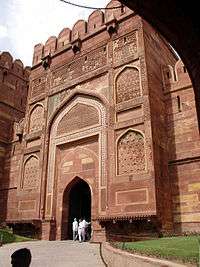
Agra Fort (sometimes called the Red Fort), was commissioned by the conquering Mughal Emperor Akbar the Great in 1565, and is another of Agra's World Heritage Sites. A stone tablet at the gate of the Fort states that it had been built before 1000 but was later renovated by Akbar. The red sandstone fort was converted into a palace during Shāh Jahān's time, and reworked extensively with marble and pietra dura inlay. Notable buildings in the fort include the Pearl Mosque or Motī Masjid, the Dīwān-e-'Ām and Dīwān-e-Khās (halls of public and private audience), Jahāngīr's Palace, Khās Mahal, Shīsh Mahal (mirrored palace), and the Musamman Burj.
The forbidding exteriors of this fort conceal an inner paradise. The fort is crescent-shaped, flattened on the east with a long, nearly straight wall facing the river. It has a total perimeter of 2.4 kilometres (1.5 mi), and is ringed by double castellated ramparts of red sandstone punctuated at regular intervals by bastions. A moat 9 metres (30 ft) wide and 10 metres (33 ft) deep surrounds the outer wall.
Chhatrapati Shīvajī visited the Agra Fort, as a result of the conditions of the Treaty of Purandar entered into with Mirzā Rājā Jaisingh to meet Aurangzeb in the Dīwān-i-Khās (Special Audience Chamber). In the audience, he was deliberately placed behind men of lower rank. An insulted Shīvajī stormed out of the imperial audience and was confined to Jai Sing's quarters on 12 May 1666. Fearing the dungeons and execution he escaped on 17 August 1666.
The fort is a typical example of Mughal architecture, effectively showing how the North Indian style of fort construction differed from that of the South. In the South, the majority of forts were built on the seabed like the one at Bekal in Kerala.[46]
Fatehpur Sikri
The Mughal Emperor Akbar built Fatehpur Sikri about 35 km (22 mi) from Agra, and moved his capital there. Later abandoned, the site displays a number of buildings of significant historical importance. A World Heritage Site, it is often visited by tourists. The name of the place came about after the Mughal Emperor Bābar defeated Rāṇā Sāngā in a battle at a place called Sikrī (about 40 km (25 mi) from Agra. The Mughal Emperor Akbar wanted to make Fatehpur Sikri his headquarters, so he built a majestic fort; but due to shortage of water, he had to ultimately move his headquarters to Agra Fort.
Buland Darwāza or 'the lofty gateway' was built by the great Mughal emperor, Akbar in 1601 CE. at Fatehpur Sikri. Akbar built the Buland Darwāza to commemorate his victory over Gujarat. The Buland Darwāza is approached by 52 steps. The Buland Darwāza is 53.63 metres (175.95 feet) high and 35 metres (115 feet) wide. it is made of red and buff sandstone, decorated by carving and black and white marble inlays. An inscription on the central face of the Buland Darwāza demonstrates Akbar's religious broadmindedness, it is a message from Jesus advising his followers not to consider this world as their permanent home.
 Dīwān-i-Khās – hall of private audience.
Dīwān-i-Khās – hall of private audience.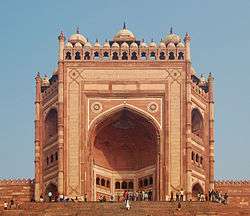 Buland Darwaza was built by Akbar the Great to commemorate his victory over the Gujarat Sultanate.
Buland Darwaza was built by Akbar the Great to commemorate his victory over the Gujarat Sultanate.
I'timād-Ud-Daulah

The Empress Nūr Jahān built I'timād-Ud-Daulah's Tomb, sometimes called the "Baby Tāj", for her father, Mirzā Ghiyās Beg, the Chief Minister of the Emperor Jahāngīr. Located on the left bank of the Yamuna river, the mausoleum is set in a large cruciform garden, criss-crossed by water courses and walkways. The area of the mausoleum itself is about 23 m2 (250 sq ft), and is built on a base that is about 50 m2 (540 sq ft) and about one metre (3.3 feet) high. On each corner are hexagonal towers, about thirteen metres (43 feet) tall. Small in comparison to many other Mughal-era tombs, it is sometimes described as a jewel box. Its garden layout and use of white marble, pietra dura, inlay designs and latticework presage many elements of the Taj Mahal.
The walls are white marble from Rajasthan encrusted with semi-precious stone decorations – cornelian, jasper, lapis lazuli, onyx, and topaz in images of cypress trees and wine bottles, or more elaborate decorations like cut fruit or vases containing bouquets. Light penetrates to the interior through delicate jālī screens of intricately carved white marble.
Many of Nūr Jahān's relatives are interred in the mausoleum. The only asymmetrical element of the entire complex are the tombs of her father and mother, which have been set side-by-side, a formation replicated in the Taj Mahal.
Akbar's Tomb, Sikandra
Sikandra, the last resting place of the Mughal Emperor Akbar the Great, is on the Delhi-Agra Highway, only 13 kilometres (8.1 miles) from the Agra Fort. Akbar's tomb reflects the completeness of his personality. The vast, beautifully carved, red-ochre sandstone tomb with deers, rabbits and langurs is set amidst a lush garden. Akbar himself planned his own tomb and selected a suitable site for it. To construct a tomb in one's lifetime was a Turkic custom which the Mughals followed religiously. Akbar's son Jahāngīr completed construction of this pyramidal tomb in 1613. The 99 names of Allah have been inscribed on the tomb.
Jamā Masjid
The Jāma Masjid is a large mosque attributed to Shah Jahan's daughter, Princess Jahanara Begum, built in 1648, notable for its unusual dome and absence of minarets. The inscription at its entrance shows that it cost Rs 500,000 at that time for its completion.

Chīnī kā Rauza
Notable for its Persian influenced dome of blue glazed tiles, the Chīnī kā Rauza is dedicated to the Prime Minister of Shāh Jahān, 'Allāma Afzal Khāl Mullā Shukrullāh of Shiraz.
Aram Bagh
The oldest Mughal garden in India, the Arām Bāgh was built by the Emperor Bābar in 1528 on the bank of the Yamuna. It lies about 2.34 km (1 mi) north of the Taj Mahal. The pavilions in this garden are designed so that the wind from the Yamuna, combined with the greenery, keeps them cool even during the peak of summer. The original name of the gardens was Ārām Bāgh, or 'Garden of Relaxation', and this was where the Mughal emperor Bābar used to spend his leisure time and where he eventually died. His body was kept here for some time before sending it to Kabul.
Mariam's Tomb
Mariams Tomb, is the tomb of Mariam, the wife of great Mughal Emperor Akbar. The tomb is within the compound of the Christian Missionary Society.
Mehtāb Bāgh

The Mehtāb Bāgh, or 'Moonlight Garden', is on the opposite bank of the River Yamuna from the Taj Mahal.
Keetham Lake
Also known as Sur Sarovar, Keetham Lake is situated about 7 kilometres (4.3 miles) from the Akbar tomb in Agra, within the Surdas Reserved Forest. The lake has an impressive variety of aquatic life and water birds.
Mughal Heritage Walk
The Mughal Heritage Walk is a part of community development programme being implemented with the support of Agra Municipal corporation, USAID and an NGO; Center for Urban and Regional Excellence. It seeks to build sustainable livelihoods for youth and women from low resource communities and improve their living environments through infrastructure services and integration within the city.
The Mughal Heritage Walk is a one-kilometre (0.62-mile) loop which connects the agricultural fields with the Rajasthani culture, river bank connected with the ancient village of Kuchhpura, the Heritage Structure of Mehtab Bagh, the Mughal aqueduct system, the Humanyun Mosque and the Gyarah Sidi.
Other places of interest
Mankameshwar Temple
The Mankameshwar Temple is one of four ancient temples dedicated to Lord Shiva located on the four corners of Agra City. It is located near the Jāma Masjid and is about 2.5 kilometres (1.6 miles) from the Taj Mahal and less than 1 km (0.6 mi) from Agra Fort. Being located in the old city, the temple is surrounded by markets, many of which date back to the Mughal Era.

Indrabhan Girls' Inter College
The college is widely considered to be the birthplace of great poet Mirza Ghalib. It is located near the Mankameshwar Temple and is about 3 kilometres (1.9 miles) from the Taj Mahal and less than 1 km (0.6 mi) from Agra Fort. Being located in the old city, the college is surrounded by markets. Approximately four or five years ago, the birth room of Mirza Ghalib was hidden behind the wall by the Management of the college to keep the identity of the place secret.[47]
Gurudwara Guru ka Taal
Guru ka Tal was originally a reservoir meant to collect and conserve rainwater built in Agra, near Sikandra, during Jahangir's reign next to the Tomb of I'tibār Khān Khwājasara in 1610. In the 1970s a gurudwara was erected here. Guru ka Tal is a holy place of worship for the Sikhs. Four of the ten Sikh Gurus are said to have paid it a visit. Enjoying both historical and religious importance, this shrine attracts a large number of devotees and tourists. Boasting elaborate stone carvings and eight of the twelve original towers. It is located by national (Delhi-Agra) highway-2.
The Cathedral of the Immaculate Conception
The Cathedral of the Immaculate Conception is the seat of the Roman Catholic Archdiocese of Agra.
Paliwal Park (Hewitt Park)
Paliwal Park, during the British Raj was known as Hewitt Park, is now renamed in memory of Shri Krishna Datta Paliwal, who was the first finance minister of Uttar Pradesh, when Shri Govind Ballabh Pant was the Chief Minister of the State.
Paliwal Park is located in the heart of Agra, spread over an area of around 70 acres (28 ha). It also has a small lake and a vast variety of trees.
Paliwal Park links the residential areas of Vijay Nagar Colony and Gandhi Nagar to the financial Hub of the city i.e. Sanjay Place.
John's Public Library, also known as the Agra Municipal Library, is also located here and has rare books on diverse topics.
Many people come here for morning walk, as a result, this place is full especially during the summer holidays when youngsters play all sorts of different games.
Soamibagh Samadhi
Located in Dayalbagh area, Soamibagh Samadhi[48] is another magnificent marble building and a popular tourist attraction. The carving of the marble pillars and posts is intricate and exhibits good craftsmanship. It is a place of worship for Radhasoami Faith followers and is dedicated to the founder of Radhasoami Faith, Param Purush Puran Dhani Soami Ji Maharaj (Sri Shiv Dayal Singh Seth). It is very quiet and peaceful inside the Satsang hall, an environment built for meditation.
Economy

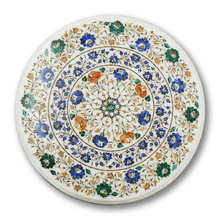

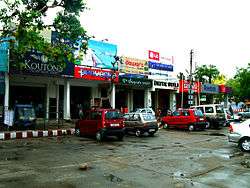

Due to the presence of the Taj Mahal and other historic monuments, Agra has a booming tourism industry as well as royal crafts like Pietra Dura, marble inlay and carpets.
Today 40% of the population depends largely on agriculture, and others on the leather and footwear business and iron foundries. Agra is the second most self-employed in India in 2007, behind Varanasi, followed by Bhopal, Indore and Patna. According to the National Sample Survey Organization, in 1999–2000, 431 of every 1,000 employed males were self-employed in the city, which grew to 603 per 1,000 in 2004–05.[49] Tourism contributes to the economy of Agra. The Tajview hotel by the IHCL was the first one in the five-star category that was opened in the city. Agra is home to Asia's largest spa called Kaya Kalp – The Royal Spa, at the Hotel Mughal in Agra.[50]
Agra has many industries. Uttar Pradesh's first plant biotech company Harihar Biotech is located near the Taj. There are about 7,000 small scale industrial units. Agra city is also known for its leather goods, the oldest and famous leather firm Taj Leather World is in Sadar bazar. The carpets, handicrafts, zari and zardozi (embroidery work), marble and stone carving and inlay work. Agra is known for its sweets (Petha and Gajak) and snacks (Dalmoth), garment manufacturers and exporters and automobile industry. Carpet making was introduced to the city by Moghul Emperor Babur and since then this art has flourished.
The city centre place at Agra has jewellery and garments shops. The silver and gold jewellery hub is at Choube Ji Ka Fatak. The Shah Market area is an electronics market while Sanjay Place is the trade centre of Agra.
Development
Agra ranked fifth on both the financial penetration index, which measures things like the presence of ATMs and bank branches, and on the consumption index, indicating the city's transformation into an urban town. There are many new buildings, shopping complexes, malls, roads, flyovers and apartments coming up. On the India City Competitiveness Index, the city ranked 26th in 2010,[51] 32nd in 2011[52] and 37th in 2012[53]
Education
It was during the advent of the Mughal era that Agra grew as a centre of Islamic education. In the year 1823, Agra College, one of the oldest colleges in India was formed out of a Sanskrit school established by the Scindia rulers. In the British era, Agra became a great centre of Hindi literature with people like Babu Gulab Rai at the helm.
Universities and colleges
and catered to colleges spread across the United Provinces, the Rajputana, the Central Provinces and almost to entire northern India. There are 10 institutes comprising various departments and around 700 Colleges are affiliated to this university. The historic Agra University was later rechristened as Dr. Bhim Rao Ambedkar University by the then Chief Minister of Uttar Pradesh, Mayawati.
- Sachdeva Institute of Technology, Also known as SIT, Mathura since 2001.
- The Institute of Mental Health and Hospital, formerly known as Agra Lunatic Asylum, was established in September 1859 governed by the State of Uttar Pradesh. It is spread over an extensive and beautiful ground of 172.8 acres (69.9 ha) land and is well-known centre for the treatment, training, and research on mental disorders in Northern India. The institute was renamed as Mental Hospital, Agra in 1925. It was being managed under the provisions of the Indian Lunacy Act, 1912 till 1993. Presently all admissions and discharges are being done under the provisions of Mental Health Act, 1987. Following a public writ, the Supreme Court of India in the year 1994, renamed the Institution as Agra Mansik Arogyashala, made it an autonomous institution and outlined the objectives to improve treatment and care of mentally ill persons including rehabilitation as well as to develop activities for professional teaching, training and research. In compliance with the order of the Supreme Court, the UP government declared the hospital as an autonomous institution on 31 January 1995. In view of the objectives laid down by the court, it was renamed as Institute of Mental Health and Hospital on 8 February 2001.
- Central Institute of Hindi, (also known as Kendriya Hindi Sansthan) is an autonomous institute under Ministry of Human Resource Development, Government of India engaged in teaching Hindi as a foreign and second language. Apart from running residential Hindi language courses for foreign students, the institute also conducts regular training programmes for teachers of Hindi belonging to non-Hindi states of India. The institute is situated at a 11 acres (4.5 ha) campus on the outskirts of Agra city. Headquartered in Agra the institute has eight regional centres in Delhi, Hyderabad, Mysore, Shillong, Dimapur, Guwahati, Ahmedabad and Bhubneshwar. The institute is the only government-run institution in India established solely for research and teaching of Hindi as a foreign and second language.
- Sarojini Naidu Medical College, is one of the three oldest medical colleges of India. It is located in Agra, Uttar Pradesh state. It is named after the first lady Governess of Uttar Pradesh, poet and freedom fighter, Bharat Kokila Smt. Sarojini Naidu.
- Agra College, is one of the oldest institutions in India. Pandit Gangadhar Shastri, a noted Sanskrit scholar founded the college in 1823. Till 1883 the institute was a government college and after that, a Board of Trustees and a Committee of Management managed the college. Agra College produced the first graduate in Uttar Pradesh and the first Law graduate to Northern India.
- St. John's College, Agra, is a college established in 1850, now part of the Dr. Bhim Rao Ambedkar University, earlier known as Agra University. It is amongst the oldest and one of the most beautiful Christian colleges in India. The college runs a study centre of Indira Gandhi National Open University, a central university.
- Raja Balwant Singh College, Established in 1885 owes its existence to Raja Balwant Singh Ji of Awagarh who enabled the institution to grow as one of the oldest and biggest colleges of Uttar Pradesh. Raja Balwant Singh College is located at Bichpuri, Agra, Uttar Pradesh, India. The college is affiliated to Uttar Pradesh Technical University, Lucknow, and Dr. B.R. Ambedkar University, Agra.
- Dayalbagh Educational Institute, Radhasoami Satsang Sabha, started the Radhasoami Educational Institute, as a co-educational Middle School, open to all, on 1 January 1917. It became a Degree College in 1947, affiliated to Agra University. In 1975, it formulated a programme of undergraduate studies which received approbation from the Government of Uttar Pradesh and the University Grants Commission, as a result of which in 1981 the Ministry of Education, Government of India, conferred the status of an institution deemed to be a University on the Dayalbagh Educational Institute, to implement the new scheme.
- UEI Global, consecutively ranked among the top management institutes of India by Competition Success Review for the year 2013 and 2012. The college has 12 campuses across India and provides programs in Hotel Management and Business Management.
Media
Agra is home to the Dainik Jagran newspaper, the most read Hindi newspaper in India. Other widely read papers include Amar Ujala, Rajasthan Patrika,Aaj, Hindustan,The Sea Express, "daily Amar Bharti", Deepsheel Bharat, DLA. The English dailies published are The Times of India, Hindustan Times, Economic Times, and The Pioneer. The Urdy dailies published are Prabhanjan Sanket, and Inksaaf. There is also the Hindi and English mixed newspaper tabloid I-NEXT.
State-owned All India Radio has a local station in Agra which transmits various programs of mass interest. There are four private FM radio stations, 92.7 BIG FM (Reliance Broadcast Network Limited), 93.7 Fever FM, 94.5 Tadka FM and Radio City 91.9 FM.[54] There is a community Radio Station 90.4 FM.
Radio stations
- 90.4 MHz – Agra ki Awaaz
- 90.8 MHz – Aap ki Awaaz
- 93.7 MHz – Fever FM
- 91.9 MHz – Radio City
- 92.7 MHz – Big 92.7 FM
- 94.5 MHz – Tadka FM
- 105.6 MHz – IGNOU Gyan Vani
Fairs and festivals
Taj Mahotsav
Taj Mahotsav is a cultural festival that was started in the year 1992 and has grown since then. The year 2019 was the 28th year of this Mahotsav. This festival also figures in the calendar of events of the Department of Tourism, Government of India. A large number of Indian and foreign tourists coming to Agra join this festivity in the month of February (18 to 27). One of the objectives of this craft fair is to provide encouragement to the artisans. It also makes available works of art and craft at reasonable prices that are not inflated by high maintenance cost.
Ram Barat
Ram Barat (Hindi: राम बारात) is a part of Ramlila celebration in Agra. It is one of the biggest annual events in North India. Ram Barat literally means Baraat Marriage procession of Sri Ram. Every year a new locality is chosen in Agra and is elaborately decorated with lights & flowers. The area is given a major facelift befitting the venue for the divine marriage.
Taj Literature Festival
Taj Literature Festival saw stars of the literary world manifest themselves on the earth of Agra. The galaxy included the stalwarts, Muzaffar Ali, Shobha De, Prahlad Kakker and Raghu Rai. The stage shone brilliant and the heritage city breathed life. This festival, an attempt to rejuvenate that aesthetic spirit which is a soul of this historically rich city, Agra. The city that nurtured the likes of Ghalib, Tansen, Surdas, Nazeer and many more.
Kailash Fair
The Kailash Fair is held in the town of Kailash, about 12 km (7 mi) from Agra, in the month of August/September. It is a major fair celebrated in honour of Lord Shiva who is believed to have appeared here in the form of stone Lingam.
Taj Municipal Museum in Paliwal Park Agra
The museum-cum-public library is housed in an old heritage structure, built in 1922 and renovated in the 1940s. Queen Victori's bronze statues are also exposed to this Museum. The other old statues and memories of the Mughal Era are exposed for the attraction of tourists, something new other than usual attraction.
Balloon Festival
Agra Balloon Festival is organised in February every year.
Notable individuals
- Abdul Karim (the Munshi)
- Amrit Lal Nagar
- Anand Swarup
- Ashi Singh
- Hazur Rai Saligram Bahadur[55]
- Makund Behari Lal
- Mamnoon Hussain
- Mirza Ghalib
- Mir Taqi Mir
- Nazir Akbarabadi
- Motilal Nehru
- Nimmi
- Raj Babbar
- Rajendra Yadav
- Seth Achal Singh
- Shiv Dayal Singh[56]
Sister cities
Agra is twinned with:
See also
References
- Lavania, Deepak (2 December 2017). "BJP wins post of Agra mayor for fifth consecutive time". The Times of India. The Times Group. Archived from the original on 23 October 2018. Retrieved 27 May 2018.
- "जिलाधिकारी - मंडलायुक्त की सूची" [List of District Magistrates and Divisional Commissioners]. Department of Appointment and Personnel, Government of Uttar Pradesh (in Hindi). Archived from the original on 10 February 2011. Retrieved 12 September 2018.
- "Officers posted at Agra Range". Uttar Pradesh Police. Archived from the original on 22 August 2017. Retrieved 12 September 2018.
- "प्रभु नारायण सिंह बने आगरा के जिलाधिकारी". Hindustan (in Hindi). 2 January 2020. Retrieved 5 January 2020.
- "Officers posted at A[gra]". Uttar Pradesh Police. Archived from the original on 22 August 2017. Retrieved 12 September 2018.
- "Census 2011". The Registrar General & Census Commissioner, India. Retrieved 21 May 2016.
- "Uttar Pradesh (India): State, Major Agglomerations & Cities – Population Statistics, Maps, Charts, Weather and Web Information". citypopulation.de. Archived from the original on 12 November 2017. Retrieved 11 November 2017.
- "52nd REPORT OF THE COMMISSIONER FOR LINGUISTIC MINORITIES IN INDIA" (PDF). nclm.nic.in. Ministry of Minority Affairs. Archived from the original (PDF) on 25 May 2017. Retrieved 7 December 2018.
- Centre, UNESCO World Heritage. "Agra Fort". whc.unesco.org. Archived from the original on 17 July 2010. Retrieved 11 November 2017.
- "Cities in India with population more than 100,000". Census2011. Archived from the original on 7 April 2013. Retrieved 10 June 2016.
- Sunil Sharma, Persian Poetry at the Indian Frontier: Masʻŝud Saʻd Salmân of Lahore
- Abraham Eraly, The Age of Wrath: A History of the Delhi Sultanate
- Abraham Eraly, The Age of Wrath: A History of the Delhi Sultanate
- W Haig, The Cambridge History of India, Cambridge University Press, London, p. 242
- "Agra Fort". Archaeological Survey of India. Archived from the original on 3 December 2009. Retrieved 8 November 2009.
- "Station: Agra Climatological Table 1981–2010" (PDF). Climatological Normals 1981–2010. India Meteorological Department. January 2015. pp. 9–10. Archived from the original (PDF) on 5 February 2020. Retrieved 19 April 2020.
- "Extremes of Temperature & Rainfall for Indian Stations (Up to 2012)" (PDF). India Meteorological Department. December 2016. p. M210. Archived from the original (PDF) on 5 February 2020. Retrieved 19 April 2020.
- http://www.census2011.co.in/census/city/115-agra.html Archived 12 April 2016 at the Wayback Machine Agra City Population Census 2011
- "Yadav village near Agra to boycott polls". Times of India. Archived from the original on 31 August 2017. Retrieved 11 November 2017.
- "District Census 2011". Census2011.co.in. 2011. Archived from the original on 11 June 2011. Retrieved 30 September 2011.
-
US Directorate of Intelligence. "Country Comparison:Population". Archived from the original on 27 September 2011. Retrieved 1 October 2011.
Moldova 4,314,377 July 2011 est.
- "2010 Resident Population Data". U. S. Census Bureau. Archived from the original on 25 December 2010. Retrieved 30 September 2011.
Kentucky 4,339,367
- "Muslim growth outsmarts Hindus for the first time in Mughal city Agra". Archived from the original on 28 December 2016. Retrieved 28 December 2016.
- Richards, John F. (1995). The Mughal Empire. Cambridge University Press. ISBN 9780521566032.
- The Gazetteer of India: History and culture. Publications Division, Ministry of Information and Broadcasting, India. 1973. p. 348. OCLC 186583361.
- "Agra City" (GIF). Imperial Gazetteer of India (Digital South Asia Library of University of Chicago). 5: 83–84. Archived from the original on 22 May 2010. Retrieved 8 November 2009.
- "CONSTITUTIONAL SETUP". Government of Uttar Pradesh. Archived from the original on 31 August 2017. Retrieved 30 August 2017.
- Maheshwari, S.R. (2000). Indian Administration (6th ed.). New Delhi: Orient Blackswan Private Ltd. pp. 563–572. ISBN 9788125019886.
- Singh, G.P. (1993). Revenue administration in India: A case study of Bihar. Delhi: Mittal Publications. pp. 26–129. ISBN 978-8170993810.
- Laxmikanth, M. (2014). Governance in India (2nd ed.). Noida: McGraw Hill Education. pp. 5.1–5.2. ISBN 978-9339204785.
- "Contact Details Of Commissioners and District Magistrates Of U.P". Department of Home and Confidential, Government of Uttar Pradesh. Archived from the original on 16 August 2017. Retrieved 12 September 2018.
- "Administration". Agra district website. Archived from the original on 28 August 2017. Retrieved 12 September 2018.
- Maheshwari, S.R. (2000). Indian Administration (6th ed.). New Delhi: Orient Blackswan Private Ltd. pp. 573–597. ISBN 9788125019886.
- Laxmikanth, M. (2014). Governance in India (2nd ed.). Noida: McGraw Hill Education. pp. 6.1–6.6. ISBN 978-9339204785.
- Singh, G.P. (1993). Revenue administration in India: A case study of Bihar. Delhi: Mittal Publications. pp. 50–124. ISBN 978-8170993810.
- "Officers posted at Agra Zone". Uttar Pradesh Police. Archived from the original on 22 August 2017. Retrieved 12 September 2018.
- "VDA Board Members". Varanasi Development Authority (in Hindi). Archived from the original on 21 August 2017. Retrieved 16 August 2017.
- "Staff List". Agra Development Authority. Archived from the original on 12 September 2018. Retrieved 12 September 2018.
- "PCS OFFICERS (Posted as HOD)". Department of Appointment and Personnel, Government of Uttar Pradesh. Archived from the original on 11 February 2011. Retrieved 21 August 2017.
- "Contact Details". Agra Municipal Corporation. Archived from the original on 22 August 2017. Retrieved 21 August 2017.
- "Agra Municipal Corporation::". 23 April 2020. Archived from the original on 23 April 2020. Retrieved 23 April 2020.
- AgraNovember 1, Siraj Qureshi; November 1, 2019UPDATED; Ist, 2019 19:43. "Zoom Air begins flights from Delhi to Agra, to add new routes. Details here". India Today. Retrieved 26 December 2019.CS1 maint: numeric names: authors list (link)
- "Agra". www.goindigo.in. Retrieved 29 February 2020.
- "कानपुर से पीएम मोदी ने किया आगरा मेट्रो का शिलान्यास, ताजनगरी में हुआ सीधा प्रसारण". Amar Ujala (in Hindi). 8 March 2019. Archived from the original on 9 March 2019. Retrieved 20 March 2019.
- Gopal, Madan (1990). K.S. Gautam (ed.). India through the ages. Publication Division, Ministry of Information and Broadcasting, Government of India. p. 173.
- Koroth, Nandakumar. History of Bekal Fort.
- "Tourist Places". www.ccestagra.gov.in. Retrieved 26 December 2019.
- "Samadhi Swamiji Maharaj Bagh". www.lonelyplanet.com. Archived from the original on 28 June 2018. Retrieved 28 June 2018.
- "India's new Entrepreneurs". Mint. 16 May 2007. Archived from the original on 18 August 2007. Retrieved 25 March 2011.
- "ITC unveils Asia's largest spa in Agra". Economic Times (India). 9 March 2008. Archived from the original on 26 December 2008. Retrieved 8 November 2009.
- Srikant Srinivas; Amit Kapoor (13 December 2010). "Boulevards of Dreams" (PDF). Businessworld. Archived from the original (PDF) on 6 January 2014.
- "India's 50 most Competitive cities". Rediff. 13 December 2011. Archived from the original on 6 January 2014. Retrieved 6 January 2014.
- "Ranks of 50 Cities as per the India City Competitiveness Index 2012" (PDF). Institute of Competitiveness, India. Archived from the original (PDF) on 21 October 2012.
- "Radio City 91.1 FM Agra – Top 10 Songs of the Week". www.radiocity.in. Archived from the original on 18 June 2017. Retrieved 11 November 2017.
- "Huzur Maharaj". www.radhasoami-faith.info. Archived from the original on 10 December 2017. Retrieved 11 November 2017.
- "Soamiji Maharaj". www.radhasoami-faith.info. Archived from the original on 27 January 2018. Retrieved 11 November 2017.
- "Agra, Chengdu of China are now sister cities - Times of India". Archived from the original on 25 August 2018. Retrieved 11 August 2018.
- "List of MoUs/Agreements signed during the Visit of the King of Jordan to India (March 01, 2018)". pib.nic.in. Archived from the original on 12 August 2018. Retrieved 11 August 2018.
- "Data Visualizations – Asia – Sister Partnerships – United States – Asia Matters for America". Data Visualizations – Asia – Sister Partnerships – United States – Asia Matters for America. Retrieved 10 January 2020.
Further reading
- Cole, Henry Hardy (1873). Illustrations of buildings near Muttra and Agra. India Office.
- Agra, Archaeological Society of (1874). Transactions of the Archaeological Society of Agra, Jan–June 1874. Delhi Gazette Press.
- Mukerji, Satya Chandra (1892). The Traveller's Guide to Agra. Sen & Co., Delhi.
- Fanthome, Frederic (1895). Reminiscences of Agra. Thacker, Spink & Co.
- Latif, Muḥammad (1896). Agra, Historical & Descriptive. Calcutta Central Press.
- Keene, Henry George (1899). A Handbook for Visitors to Agra and Its Neighbourhood (Sixth ed.). Thacker, Spink & Co.
- Smith, Edmund W. (1901). Moghul Colour Decoration of Agra, Part I. Govt. Press, Allahabad.
- Havell, Ernest Binfield (1904). A Handbook to Agra and the Taj, Sikandra, Fatehpur-Sikri, and the Neighbourhood. Longmans, Green & Co., London.
- Agranama: The authentic book about the history of Agra by Mr. Satish Chandra Chaturvedi
- Ashirbadi Lal Srivastava, History and Culture of Agra (Souvenir), 1956
External links
| Wikiquote has quotations related to: Agra |
.jpg)

